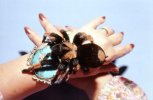- Messages
- 102
- Location
- Anywhere in North America.
Hi guys! I'm new, and I'm thinking about getting a tarantula in the future. I wanted to know, 1. what the best type of tarantula would be for beginners. 2. what name i should give it. 3. some tips for taking care of it. Thank you in advance for the help!
Casey (a.k.a., Grayson_the_spider_gal) -
Welcome to the hobby (in anticipation)!
There are about 1,000 species of tarantulas known to science, and the majority of them would make good, first pets. We have a very large playing field here!
First, some suggested characteristics to look for. All tarantulas possess a venom, and many have a venom that produces a severe reaction in humans, although nobody on record has died yet. (The joke with a few kinds is that you won't die, but you may wish you would!) Bites by those are often called "medically significant bites." Choose a kind without a medically significant bite. The vast majority of tarantulas do not have medically significant bites. But if you have doubts or questions about your favorite spider, check back with us on this forum before buying any.
Choose a kind known to be docile and handleable. Those that are not inherently docile may pose too great a challenge for the beginner. Besides, you need to leave something for your next tarantula.
Handling is a hotly debated topic in the hobby. I can't go into it here in depth. There simply isn't enough space. Having said that, strictly speaking, handling is not necessary, but many of us like to interact with our pet tarantulas on that more personal level. I included handling just in case you later wanted to get a little personal with your newfound little buddy. How do you know which are and which aren't? Check with us on this forum before buying any, but prepare yourself for a largely irrelevant, very much heated debate!
Not a requirement, but a strong recommendation: Buy baby tarantulas in threes. It's very hard to determine sex in very small tarantulas, and some dealers, by plan or by accident, are not very good at all at the task. (Adult-sized tarantulas are much easier to determine sex in.) Whenever buying a baby tarantula, assume (regardless of what the dealer or clerk tells you) that you have a 50/50 chance of getting either sex. If that's true, if you buy three, there's seven chances out of eight that you'll get at least one female. And, between the sexes, females make better pets than the males. Why? It's complicated. Read about it in a good tarantula book. (See below.)
Choose individuals with diagonal leg spans (DLS) of at least one inch. Tarantulas of this size and greater have generally grown out of the very fragile, baby stage. Buying tiny, wee, babies as a beginner may be too much to deal with at first. Besides, they look too much like common house spiders if too small.
Generally, steer yourself towards one of the New World (North, Central, and South American, and neighboring islands) species at first. Yes, I know that there are a bunch of very pretty, Old World kinds to tempt you, and I would encourage you to get a few as pets ... but later. As a novice, you want to go slowly and carefully. You're on the very steepest part of the learning curve and there's no good reason why you need to stack the cards against yourself at the moment. Besides you need to save something else for later.
Now, where can I start with good kinds to keep? Everybody has their favorites, and we are all biased strongly in favor of our first tarantulas. What I'm giving you here is what I found to be almost guaranteed survivors, and to make good pets.
Any North American tarantula (genus Aphonopelma) except the Rio Grande gold (A. moderatum). RGGs are a bit nippy and therefore do not fall into the docile/handleable category. Some hobbyists complain that the North American kinds are too drab, usually being brownish to black. But even the so-called drab ones have great personalities and subtle coloring that you'll soon get to like. They're typically hardy, docile, and long lived.
Just about any of the Brachypelma-oid tarantulas from Central America. They've recently undergone some name changes and you may have difficulty sorting them out. For instance, one of my absolute best favorites used to be called Brachypelma albopilosum, but is now called Tliltocatl albopilosus. And I would extremely strongly recommend this kind as a first pet. Besides being hardy, docile and long lived, they're also smart! For a spider, that is. Maybe this is something we should take up as a different thread, however.
Many of the Grammostola make excellent pets. The Brazilian black (G. pulchra), the Entre Rios (G. iheringi), and even the Chilean rose (G. rosea), if they're still available, are good choices.
Many people would recommend some of the Avicular-oid tarantulas as well. The Guiana pinktoe (Avicularia avicularia) and the Martinique treespider (Caribena versicolor, formerly Avicularia versicolor) are examples. But, I've found that they do not ship quite as well as most other tarantulas, and their mortality rate is a little higher. I would strongly recommend them as a second tarantula, however.
Several more hints: Read a good book on tarantulas. There are a number on the market. You needn't buy one at first, most are available in your neighborhood public library for check-out. Go there and thumb through them. Check out and read those that seem to be the better ones. If you find one that you really like, buy a copy or an ebook edition for home use. Few of those books are going to cost more than a dead tarantula! (Although some pubic libraries are opening now, many are still closed because of the COVID-19 pandemic. Call ahead if it's important. And, if they're open, check out one or more of the books and read them at home.)
Visit this website: Spiders, Calgary. Read one or two of the included web pages a day. There's a huge amount of info there that's intended specifically for novices. WARNING: Trying to read all the webpages at one sitting has been known to cause significant brain damage!
Be very, VERY, VERY cautious about following recommendations on printed care sheets and Internet videos! Don't truly believe anything from those two sources unless you can verify what they expound either on this forum or by consulting experienced arachnophiles. YOU'VE BEEN WARNED!
"May all the holes in your path hold large, fuzzy spiders!
------------------------------------------------------------------------
Has no one told you of the tarantula enthusiast's lament?
"LIKE THOSE POTATO CHIPS, YOU CAN'T HAVE JUST ONE!"
YOU'VE BEEN WARNED!
------------------------------------------------------------------------
Question: What's worse than finding a poisonous spider in your motorhome?
Answer: Losing a poisonous spider in your motorhome!
(I live in a motorhome! - SAS)
------------------------------------------------------------------------
Stan Schultz


